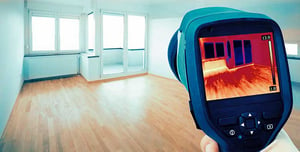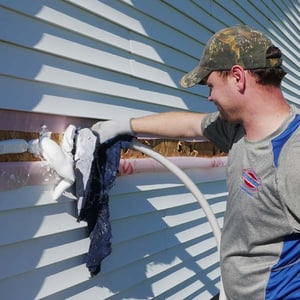The Complete List of Foam Insulation Terms and Definitions


When you’re researching foam insulation for your home some of the terms might leave you scratching your head.
What the heck is a wythe cavity anyways? Is thermal bridging an actual bridge?
Those are just a couple of the terms you might see during your research but don’t get overwhelmed, we’re going to help you out.
While RetroFoam of Michigan doesn’t serve as a dictionary, we are a foam insulation contractor and we know what all of these terms mean. We work with homeowners every single day and pride ourselves in our continued efforts of providing education to them so they can make the best decision for their home insulation needs.
Foam Insulation Terms and Definitions
We don’t want to leave you hanging, so let’s jump right into this list of foam insulation terms and definitions.
- R-Value: R-Value is the capacity of insulation to resist heat flow. In the case of fiberglass and cellulose, the higher the R-Value
 the higher the insulating power. R-Value doesn’t tell the whole story when it comes to foam insulation as the material creates an air seal that stops air leakage into and out of a home.
the higher the insulating power. R-Value doesn’t tell the whole story when it comes to foam insulation as the material creates an air seal that stops air leakage into and out of a home. - Building Envelope: A building envelope is defined as part of the structure that separates the outdoor environment from the inside of your home. That sounds a little complicated so here’s this – the building envelope surrounds your living space separating it from unconditioned spaces and the outdoors. When you air seal your home think of it like an actual envelope. The foam is sealing the envelope to keep the contents inside safe.
- Air Seal: An air seal is literally a seal that prevents the passage of air and vapor. An air seal created by foam insulation works to block air movement into and out of your home.
- Roof Deck: This is a two for one deal because you can’t talk about the roof deck without mentioning the attic flat. When insulating an attic with spray foam, either the underside of the roof, known as the roof deck, or the attic floor, known as the attic flat, are recommended.

- Rim Joist: The rim joist, also known as band joists, is the area where your foundation wall, exterior wall, and subfloor meets. It’s an area that has often been left uninsulated in older homes.
- Thermal Bridging: A thermal bridge occurs in your home when there is a break in the building envelope, like in the insulation. This means if there is an interruption in your insulation, then space is created where air can move through into and out of your home.
- Vapor Barrier: The job of a vapor barrier is to slow down the movement of water vapor into your home. It can be placed anywhere in your home that there is a high risk of moisture getting into the building envelope like the attic, crawl space, or basement. A house wrap is considered a vapor barrier.
- Continuous Insulation: Continuous insulation, just like the name implies, is continuous insulation that spans the structure without thermal bridging. An example of continuous insulation would be house wrap.
- Blower Door Test: A blower door test is done to test the airtightness of your home using a special fan called a blower door. The blower door is a powerful fan that is mounted to the frame of an exterior door of your home. It pulls air out of the house, lowering the air pressure inside. If there are air leaks in your home, this test makes it so the higher outdoor air pressure finds its way in through those leaks.
- Wythe Cavity: The wythe cavity is a small air space between the brick exterior and the stud cavity of a home. On one side there is brick and on the other, there is sheathing that separates it from the stud cavity.
- Passing Code Through Performance: Passing code using performance is how you can do it without worrying about prescriptive R-Value. This is done with foam insulation based on the air seal is created and the home’s performance after installation must be tested using REScheck or the HERS Index.
- Prescriptive Code: Prescriptive code is what an insulation contractor, specifically for fiberglass and cellulose, uses to pass code. Prescriptive code is a set R-Value for a home determined by the climate zone where it is located.
- Injection Foam Insulation: Injection foam is an insulation and air barrier that seals enclosed cavities like existing walls. It is
 usually installed from the outside by removing a row of siding, drilling a hole into the stud cavity, and injecting the foam. The installation can be done from the inside on certain occasions depending on the project.
usually installed from the outside by removing a row of siding, drilling a hole into the stud cavity, and injecting the foam. The installation can be done from the inside on certain occasions depending on the project. - Spray Foam Insulation: Spray foam is an insulation and air barrier used to insulate open wall cavities, attics, crawl spaces, and rim joists. Spray foam can be either open cell or closed cell – both create an air seal.
- Open Cell Spray Foam Insulation: Open cell spray foam is a continuous insulation that creates an air seal used in open cavities and pole barns. Open cell has a high expansion rate, is pliable, aids in sound dampening, and allows moisture to move through it, but doesn’t retain it.
- Closed Cell Spray Foam Insulation: Closed cell spray foam is a spray-applied plastic that forms into a continuous insulation and air seal in open cavities in homes and in pole barns. Closed cell has a low expansion rate, is dense, and doesn’t allow moisture to move through it.
- Fiberglass Insulation: Fiberglass insulation is made of extremely fine glass fibers and is found in most homes. Fiberglass insulation can be found in either batts or loose-fill.
- Cellulose Insulation: Cellulose insulation is the oldest form of home insulation. It can be made of either recycled newspaper or denim and is found as either a loose-fill or blown-in insulation.
- Firestop: A firestop is a horizontal wall in a wall cavity that is designed to maintain the fireproofing of a wall assembly allowing it to impede the spread of fire and smoke.
- High-Pressure Foam Insulation: High-pressure spray foam is the insulation material used by experienced contractors. That’s because to create that high pressure for the hose and the gun, the system is run out of a truck with a generator where the foam is mixed in a proportioner. This professional machine is only used by experienced contractors to ensure the spray foam is mixed properly.
- Low-Pressure Foam Insulation: Low-pressure spray foam can be found at many home improvement stores in the form of a DIY kit. Low-pressure kits should only be used for small projects like around doors, headers around windows, or to fill in the spaces around your cold air returns.
- Froth Pack: A froth pack, or DIY spray foam kit, is a low-pressure polyurethane spray foam. They come in various sizes and are usually a two-component quick set foam kits that come with foam, hoses, spray gun, and extra nozzles. These DIY spray foam kits can be used to create an air seal in areas of your home if the foam is applied correctly.
- REScheck: REScheck is used to assist insulation contractors in proving energy code compliance and creates the reports necessary for code officials. REScheck is one of the most popular and common programs used when it comes to testing performance. It is so popular because it is fast and easy and once you enter the data, it immediately tells you whether you have passed or failed.
- HERS Index: The Home Energy Rating System (HERS) Index is a test used to measure a home’s energy efficiency. It's also recognized as a system for inspecting and calculating a home’s energy performance.
- Stack Effect: Stack effect is when the air comes in through your crawl space or basement, moves up through your floors and walls, and finally makes its way to your attic and out. This is cold air in the winter and hot air in the summer that puts extra strain on your AC unit and furnace.

- Insulation Contractor: An insulation contractor is a contractor who installs insulation. Some insulation contractors do a little bit of everything, for example, they may install fiberglass and spray foam. Others are more specialized and only deal with one insulation material.
- BPI Certification: Building Performance Institute (BPI) offers certifications, standards, as well as programs like BPI GoldStar Contractor, Rater, and Product Listing. BPI is the source for certified contractors working on home energy efficiency, comfort, durability, health, and safety.
- Home Performance: Home performance is when all of the systems in your home work together to create the most comfortable, efficient living space.
- Flash and Batt: Flash and batt is spray foam insulation with fiberglass batts. It’s a technique used by some insulation contractors where a flash of closed cell spray foam at 1- to 2-inches is applied in an effort to create an air seal and then puts fiberglass batt insulation over it. It’s typically done in walls.
- Sound Deadening: Sound dampening, or sound deadening, is reducing noise in a room or structure. This does not mean the space is completely soundproof. Foam insulation can reduce sound transmission by up to 80 percent.
- Soundproofing: Soundproofing a room or structure means you are making it resistant to the passage of sound.
- Energy Audit: An energy audit is done to determine the energy efficiency of a home. This can be done as either a DIY energy
 audit, assessments from energy providers, and professional BPI-certified auditors.
audit, assessments from energy providers, and professional BPI-certified auditors. - Fire Rating: The fire rating system for insulation is basically how long the material can withstand a standard fire resistance test. The Class 1 Fire Rating definition is the flame spread index and smoke development index, which means how fast a flame will spread when introduced to the material and how much smoke it produces.
- Hot Roof: The term hot roof comes from the earliest days of insulating attics. Some people believed insulation was actually a heat source, even though in actuality it is a barrier between two areas of different temperatures. Another term that describes a hot roof much better is an unvented attic. If the roof deck of your home has been insulated, it is actually now a part of your home’s conditioned space. This is a great benefit as it helps prevent ice dams and helps save you money on monthly energy bills.
- Off-Gassing: Off-gassing or volatile organic compound (VOC) is all of the little bits that are expelled during the process of spraying something. Spray foam does off-gas and there are some health and odor concerns with off-gassing, but only when it happens in large amounts. When considering spray foam insulation for your home and you’re concerned about off-gassing, look for products that are labeled “low-VOC.”
Learn More About Foam Insulation
You’re now familiar with the terms and definitions associated with foam insulation.
This might be the first step of your journey in learning about foam insulation. If you’d like to learn even more about the benefits of foam insulation when it comes to energy efficiency and comfort, check out the Learning Center on our website.
About Amanda Ringler
Amanda previously has worked as a breaking news and crime reporter, TV news producer, and editor in Flint and Detroit. Throughout her career as a journalist, she has won several awards from The Society of Professional Journalists - Detroit Chapter and the Michigan Press Association. As part of the RetroFoam of Michigan family, Amanda uses her experience as a journalist to write content that will help educate homeowners on the benefits of foam insulation. When Amanda isn’t writing, she’s spending time with her husband and rescued huskies. She also loves knitting, making art, cooking, and hosting dinner and a movie night for friends and family.

.jpg)
